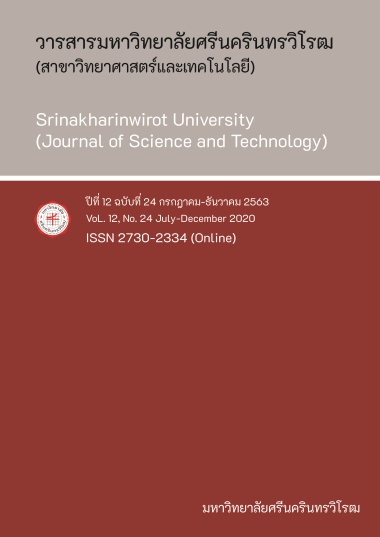การเปรียบเทียบค่าความร้อนของก้อนเชื้อเพลิงจากส่วนผสมของถ่านกะลามะพร้าวและก้อนเห็ดหลังการเก็บผลผลิต A COMPARISON OF HEATING VALUE OF FUEL BRIQUETTE FROM THE MIXTURE OF COCONUT SHELL CHARCOAL AND MUSHROOM CUBE AFTER
Keywords:
Heating value of fuel briquette, Coconut shell charcoal, Mushroom cube after harvestAbstract
The present research article aims to produce fuel briquette and find the different ratios of heating value of fuel briquette from the mixture of coconut shell charcoal and mushroom cube after harvesting. The fuel briquette was produced in various mixing ratio of coconut shell charcoal and mushroom cube after harvesting. The ratios were 0:10, 1:9, 2:8, 5:5, 8:2, 9:1 and 10:0 and mixed with cassava glue. After pressing fuel briquette in cylindrical shape, dry them in the sun. The fuel briquettes were measured and finding the density, moisture content, the heating value and performance testing. The research finding revealed that the optimal proportion ratio of the mixture of coconut shell charcoal and mushroom cube after harvest were 8:2 and 9:1 which provided the density of fuel briquette at 584.14 and 661.10 kg/m3. The moisture content was 2.17 and 2.08% db. The heating value was 5,695.76 and 6,448.61 kcal/kg. The burning time was 210.12 and 198.98 min/kg. The ash was 3.32 and 6.68 %. The ratio of 8:2 and 9:1 had heating value higher than the heating value of the standard mark on the community product; the minimum heating value was 5,000 kcal/kg. Therefore, to produce the fuel briquette, the mixing ratio 8:2 and 9:1 of coconut shell charcoal and mushrooms cube after harvest were recommended for the community to increase value added from the agricultural wastes.
Downloads
References
[2] Kanya Maomesap. (2001). Production of Fuel Briquettes from Biomass and Pyrolysis Process. Energy Efficiency Journal, 11(52), 42-48.
[3] Jularat Chawkumpang. (2011). A Study and Development of Bio-Coal in household Industry. Master Thesis, M.Ed. (Energy Engineering). Khon Kaen: Khon Kaen University.
[4] Pornsatit Yongyuen. (2004). Produce Charcoal Briquettes for International Competition. 1th ed. Ayutthaya: Thai Sumi Company.
[5] Kittiphoom Suppalakpanya; Ruamporn Nikhom, & Suwattana Nikhom. (2018). The Production of Charcoal Briquette by used Mushroom Loaf and Durian Rinds. In Proceeding of the 28th National Conference on Chemical Engineering and Applied Chemistry of Thailand. pp. 110-114. Chonburi:
Burapha University.
[6] ASTM International. (2003). Standard Test Method for Moisture in the Analysis Sample of Coal and Coke. ASTM D3173. USA.
[7] ASTM International. (2010). Standard Test Method for Gross Calorific Value of Coal and Coke. ASTM D5865. USA.
[8] Tarinee Mahayotsanun. (2005). Study Design and Manufacture of Charcoal Production Machines for Household Level Production. Master Thesis, M.Ed. (Agricultural Engineering). Bangkok: Kasetsart University.
[9] Thai Industrial Standard Institute. (2004). The Standard of Community Product for Refuse Derived Fuel 238/2547. Retrieved October 15, 2014 , from https://www.tisi.go.th/public/StandardList.aspx
Downloads
Published
How to Cite
Issue
Section
License
Srinakharinwirot University Journal of Sciences and Technology is licensed Under a Creative Commons Attribution-NonCommercial-NoDerivs 4.0 International (CC-BY-NC-ND 4.0) License, Unless Otherwise Stated. Please Read Journal Policies Page for More Information on Open Access, Copyright and Permissions.



